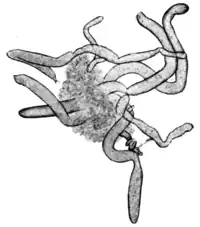XLI]
THE PARASITE
747

Fig. 137.—Bilharzia daughter-sporocysts teased from liver. (Leiper.)
branches do not unite until late, resulting in a short cæcum. In S. mansoni, reared from Planorbis boissyi, there are eight or nine testes, and the gut branches unite early, forming a long cæcum. In S. hæmatobium the uterus contains many eggs, whereas in S. mansoni it is short and contains only one or two eggs. S. mansoni, unlike S. hæmatobium, always causes a heavy deposition of black granules in the liver of the human host. "Lastly, as regards habitat. The males of S. hæmatobium appear to leave the liver early and to pass down into the finer branches of the mesenteric veins before they attain maturity. The females found in the gynæcophoric canal are diminutive. The males of S. mansoni remain in the liver until the females in copula begin to lay eggs, and large numbers of lateral-spined eggs are frequently laid in series by coupled worms in the veins even of the edge of the liver."